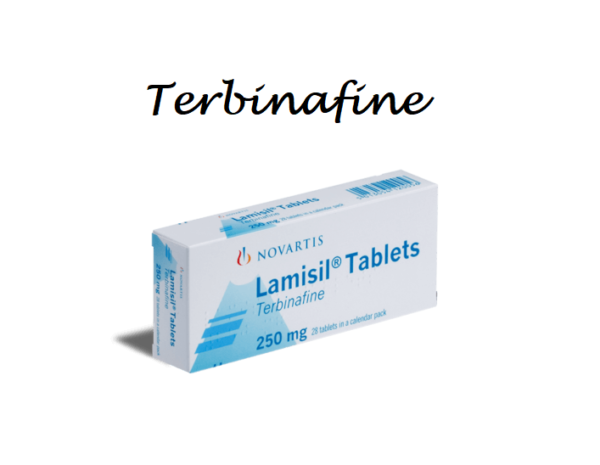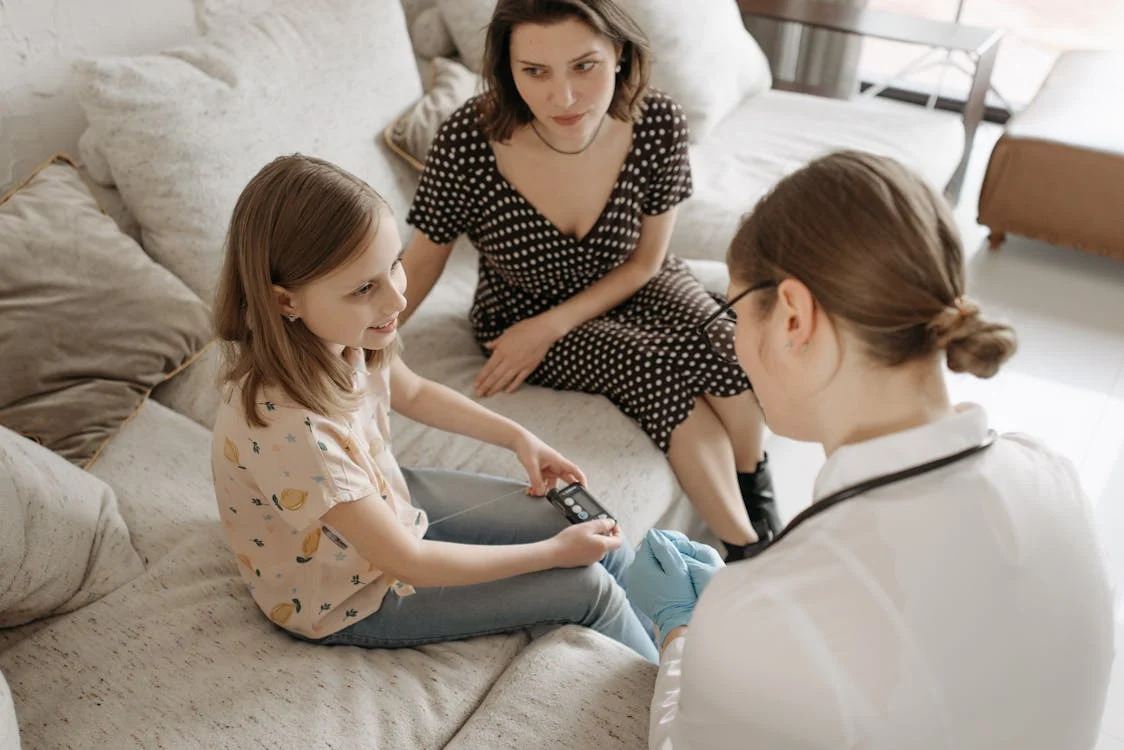Terbinafine is an antifungal medication primarily used to treat fungal infections of the skin and nails, such as athlete's foot, ringworm, and fungal nail infections. It is available in various forms, including oral tablets, creams, and sprays.
Terbinafine (Lamisil) is an antifungal medicine that is available both as oral tablets and topical formulations for the treatment of fungal infections.
- Onychomycosis (tablets only):
- It is used to treat dermatophyte-caused onychomycosis of the toenail or fingernail (tinea unguium).
- Tinea capitis (granules only):
- Patients 4 years of age and older can use it to treat tinea capitis.
- Off Label Usage of Terbinafine in Adults:
- It is also used in following conditions:
- Dermatophyte folliculitis (tinea barbae, Majocchi granuloma);
- Sporotrichosis (lymphocutaneous and cutaneous);
- Tinea capitis;
- Tinea corporis/tinea cruris/tinea faciei;
- Tinea pedis/tinea manuum
Terbinafine Dose in Adult
Terbinafine dosage in the treatment of Onychomycosis:
Continuous Dosing:
- For fingernail fungus: Take 250 mg of terbinafine in tablet form once a day for 6 weeks.
- For toenail fungus: Take 250 mg of terbinafine in tablet form once a day for 12 weeks.
Pulsed Dosing (an alternative method that's not standard but sometimes used):
- Method 1: Take 250 mg once daily for 4 weeks, then take no medicine for the next 4 weeks, and then repeat another 4 weeks of 250 mg once daily.
- Method 2: Take 250 mg twice daily for 1 week, then take no medicine for the next 3 weeks. This cycle is repeated for 3 months.
Pulsed dosing might be chosen because it can potentially lessen side effects, lower costs, and make it easier for patients to stick to their treatment plan, although it's generally less effective than continuous dosing.
Terbinafine Dosage in the treatment of Sporotrichosis, lymphocutaneous and cutaneous (alternative agent for patients who do not respond to itraconazole) (off-label):
- Dose: Take 500 mg of terbinafine orally, twice daily.
- Duration: Continue the treatment for 2 to 4 weeks after all lesions have healed. Typically, the total treatment period lasts between 3 to 6 months, depending on the response and severity of the infection.
This dosage and treatment duration is based on guidelines and recommendations from sources like the Infectious Diseases Society of America (IDSA).
Terbinafine Dosage in the treatment of Tinea infections:
- Dermatophyte Folliculitis (such as tinea barbae and Majocchi granuloma):
- Dose: 250 mg orally, once daily.
- Duration: Typically 2 to 6 weeks, but may need to be extended, especially in immunocompromised patients or those with a slow response.
- Tinea Capitis:
- Dose: 250 mg orally, once daily.
- Duration: 4 to 6 weeks.
- Tinea Corporis, Tinea Cruris, Tinea Faciei:
- Note: This is an alternative treatment option for patients with extensive skin involvement or when topical therapy has failed.
- Dose: 250 mg orally, once daily.
- Duration: 1 to 2 weeks.
- Tinea Pedis (athlete’s foot) and Tinea Manuum (hand fungus):
- Note: Used as an alternative treatment for cases with extensive skin involvement or when topical therapy has failed.
- Dose: 250 mg orally, once daily.
- Duration: 2 weeks.
Terbinafine dose in Children
Terbinafine Dosage in the treatment of Tinea capitis:
- Children weighing less than 25 kg: 125 mg once daily for 6 weeks.
- Children weighing 25 to 35 kg: 187.5 mg once daily for 6 weeks.
- Children weighing more than 35 kg: 250 mg once daily for 6 weeks.
It's important for this treatment to continue for the full duration to ensure the infection is completely cleared. This dosing applies specifically to children who are 4 years of age and older.
Terbinafine dosage in the treatment of Onychomycosis:
- Children weighing 10 to 20 kg:
- 62.5 mg once daily
- Duration: 6 weeks for fingernails, 12 weeks for toenails
- Children weighing 20 to 40 kg:
- 125 mg once daily
- Duration: 6 weeks for fingernails, 12 weeks for toenails
- Children weighing over 40 kg:
- 250 mg once daily
- Duration: 6 weeks for fingernails, 12 weeks for toenails
This treatment plan should be monitored closely by a healthcare provider, especially considering the varying durations based on the location of the fungal infection (fingernails vs. toenails) and the limited data available on pediatric use for this condition. It's crucial to ensure that the dosing is appropriate for the child's weight and the severity of the infection.
Terbinafine pregnancy Risk category: B
- There is limited information about the safety of using systemic terbinafine (taken by mouth) during pregnancy.
- Therefore, it is generally not recommended to use this medication for treating fungal infections like onychomycosis (nail fungus) or tinea capitis (scalp fungus) when pregnant.
- This recommendation is based on concerns about potential risks to the developing baby.
Terbinafine use during breastfeeding:
- Terbinafine can pass into breast milk, with a breastfed baby receiving around 4% of the dose their mother takes.
- Due to this, it's generally not recommended to breastfeed while undergoing systemic (oral) terbinafine therapy for fungal infections.
- However, the decision to breastfeed during treatment should be carefully weighed, considering factors such as the potential risk of the infant being exposed to the medication, the benefits of breastfeeding for the baby, and the benefits of the treatment for the mother's health.
Terbinafine (Lamisil) dose in renal disease:
- The manufacturer's instructions don't include specific dosage adjustments for different situations because it hasn't been studied.
- However, it's noted that in patients with a reduced kidney function (measured as creatinine clearance of 50 mL/minute or less), the body clears terbinafine at a slower rate, about 50% slower than usual.
Terbinafine Dose in Liver Disease:
- If someone has chronic or active liver disease, it's not safe for them to take terbinafine.
- This medication is not recommended for people with liver problems because it could potentially worsen their condition or cause further damage to the liver.
Common Side Effects of Terbinafine Include:
- Central nervous system:
- Headache
Less Common Side Effects of Terbinafine Include:
- Dermatologic:
- Skin Rash
- Pruritus
- Urticaria
- Gastrointestinal:
- Diarrhea
- Vomiting
- Dyspepsia
- Upper Abdominal Pain
- Dysgeusia
- Nausea
- Abdominal Pain
- Pharyngolaryngeal Pain
- Toothache
- Hepatic:
- Liver Enzyme Disorder
- Infection:
- Influenza
- Ophthalmic:
- Vision Color Changes
- Decreased Visual Acuity
- Respiratory:
- Nasopharyngitis
- Cough
- Upper Respiratory Tract Infection
- Nasal Congestion
- Rhinorrhea
- Miscellaneous:
- Fever
Contraindication to Terbinafine Include:
- If someone is allergic to terbinafine or any part of the medication, or if they have chronic or active liver disease, they should not take terbinafine.
- This is because it could trigger an allergic reaction or worsen their liver condition.
Warnings and precautions
Antifungal hypersensitivity to Allylamine
- If someone is sensitive or allergic to allylamine antifungal medications like naftifine or butenafine, they should be cautious when using terbinafine.
- There's a possibility of cross-sensitivity, meaning that their body might react to terbinafine similarly to how it reacts to other allylamine antifungals.
Depression
- Some people have reported experiencing depression while using terbinafine.
- Patients should be instructed to report any symptoms of depression or changes in mood while taking this medication.
Gastrointestinal effects:
- Terbinafine can sometimes cause gastrointestinal issues, including taste disturbances such as a loss of taste.
- In severe cases, this can lead to decreased food intake, weight loss, and even feelings of anxiety or depression.
- It's important to note that these taste disturbances may not resolve immediately after stopping the medication and could take several weeks to over a year to improve, or in some cases, the disturbance may be permanent.
Hematologic effects
- Terbinafine can sometimes affect blood cell counts, particularly lymphocytes and neutrophils.
- In clinical trials, temporary decreases in lymphocyte counts were observed, and in rare cases, severe neutropenia (low levels of neutrophils) has occurred, which typically reverses after stopping the medication.
- If terbinafine therapy is planned to continue for longer than 6 weeks in patients with preexisting immune system suppression, it's important to monitor their complete blood count (CBC).
- If the absolute neutrophil count (ANC) falls below 1,000/mm³, it's recommended to discontinue terbinafine therapy.
Hepatic failure
- Terbinafine has been associated with cases of hepatic failure, some of which have led to liver transplant or death.
- This serious side effect can occur in patients both with and without preexisting liver disease.
- Hepatic events may be more severe in patients with active or chronic liver conditions.
- To monitor for liver problems, it's important to conduct baseline and periodic liver function tests while using terbinafine.
- If any signs of liver injury develop, such as nausea, loss of appetite, fatigue, vomiting, abdominal pain (especially in the upper right area), jaundice (yellowing of the skin or eyes), dark urine, or pale stools, or if liver function tests show elevated levels, terbinafine should be discontinued promptly.
- Early detection and discontinuation of the medication are crucial to prevent further liver damage.
Hypersensitivity
- Terbinafine can trigger serious skin and hypersensitivity reactions, such as Stevens-Johnson syndrome, toxic epidermal necrolysis, erythema multiforme, exfoliative dermatitis, bullous dermatitis, and drug reaction with eosinophilia and systemic symptoms (DRESS) syndrome.
- If a patient develops a progressive skin rash or shows signs and symptoms of a hypersensitivity reaction while taking terbinafine, it's crucial to discontinue the treatment immediately.
- These reactions can be severe and potentially life-threatening, so prompt action is essential to ensure the patient's safety.
Ocular effects
- While rare, terbinafine use has been associated with changes in the ocular lens and retina.
- These ocular effects may occur, prompting the need for discontinuation of therapy.
- If a patient experiences any changes in vision or other ocular symptoms while taking terbinafine, it's important to seek medical attention promptly.
- Ophthalmologic evaluation may be necessary to assess the extent of ocular changes and determine whether discontinuing the medication is necessary to prevent further complications.
Respiratory effects
- Terbinafine use has been associated with respiratory effects, particularly disturbances in smell, including loss of smell.
- In some cases, these disturbances may persist even after discontinuation of therapy, and in rare instances, they may become permanent.
- If a patient experiences symptoms of smell disturbance while taking terbinafine, it's important to discontinue the therapy and seek medical advice.
- Resolution of these symptoms may take time, with some cases taking over a year to improve.
- However, if the disturbance persists or becomes permanent, further evaluation and management may be necessary.
Thrombotic microangiopathy
- Terbinafine use has been associated with cases of thrombotic microangiopathy (TMA), including serious conditions like thrombotic thrombocytopenic purpura and hemolytic uremic syndrome.
- Some of these cases have been fatal.
- If a patient develops symptoms suggestive of TMA, such as unexplained thrombocytopenia (low platelet count) and anemia (low red blood cell count), it's important to consider the possibility of TMA and promptly discontinue terbinafine therapy.
- Early recognition and discontinuation of the medication are crucial in managing this potentially life-threatening condition.
Autoimmune disease (Lupus).
- Terbinafine use has been linked to the precipitation or worsening of both cutaneous (skin) and systemic (affecting multiple organs) lupus erythematosus, an autoimmune disease.
- If signs or symptoms of lupus, such as skin rashes, joint pain, or other systemic symptoms, develop while taking terbinafine, it's important to discontinue the medication.
- This precaution is essential to prevent further exacerbation of lupus symptoms and to manage the condition appropriately.
Hepatic impairment
- Terbinafine use is not recommended for individuals with active or chronic liver disease.
- The medication is contraindicated in such cases.
- Even in patients with hepatic cirrhosis, terbinafine clearance is reduced by approximately 50%.
- Therefore, caution should be exercised, and alternative treatments may be considered for patients with hepatic impairment to avoid potential adverse effects and further liver damage.
Renal impairment
- In patients with renal dysfunction, particularly those with a creatinine clearance (CrCl) of 50 mL/minute or less, terbinafine should be used cautiously.
- The clearance of terbinafine is reduced by approximately 50% in such individuals.
Terbinafine (systemic): Drug Interaction
|
Ajmaline |
Ajmaline's serum levels may rise after taking CYP2D6 Inhibitors (Moderate). |
|
Amphetamines |
The serum levels of amphetamines may rise in response to CYP2D6 Inhibitors (Moderate). |
|
ARIPiprazole |
The serum concentration of ARIPiprazole may rise in response to moderately potent CYP2D6 inhibitors. Management: Keep an eye out for enhanced pharmacologic effects of aripiprazole. Depending on the concurrent therapy and/or the indication, aripiprazole dosage modifications may or may not be necessary. For detailed advice, refer to the complete interaction monograph. |
|
Brexpiprazole |
Brexpiprazole's serum levels may rise in the presence of moderate CYP2D6 inhibitors. Treatment: The dose of brexpiprazole should be halved if it is combined with a strong or moderate CYP3A4 inhibitor and both a moderate or strong CYP2D6 inhibitor. |
|
CloZAPine |
The serum levels of CloZAPine may rise after taking CYP2D6 Inhibitors (Moderate). |
|
Codeine |
The therapeutic benefit of codeine may be diminished by moderate CYP2D6 inhibitors. These CYP2D6 inhibitors might stop codeine from being metabolically converted to its active metabolite, morphine. |
|
CYP2D6 Substrates (High risk with Inhibitors) |
The metabolism of CYP2D6 Substrates may be decreased by moderate CYP2D6 Inhibitors (High risk with Inhibitors). Tamoxifen is an exception. |
|
Fesoterodine |
The active metabolite(s) of fesoterodine may be present in higher serum quantities when taking CYP2D6 inhibitors. |
|
Indoramin |
The serum levels of Indoramin may rise after taking CYP2D6 Inhibitors (Moderate). |
|
Metoprolol |
Metoprolol's serum levels may rise when taking CYP2D6 Inhibitors (Moderate). |
|
Nebivolol |
Nebivolol's serum levels may rise in response to moderate CYP2D6 inhibitors. |
|
Pitolisant |
Pitolisant's serum levels may rise in response to CYP2D6 Inhibitors (Moderate). |
|
Propafenone |
Propafenone's serum levels may rise when taking CYP2D6 Inhibitors (Moderate). Management: Separate drug interaction monographs go into further detail about the medications indicated as exceptions to this book. |
|
RifAMPin |
May reduce the serum level of Terbinafine (Systemic). |
|
Tamsulosin |
Tamsulosin's serum levels may rise in response to moderately potent CYP2D6 inhibitors. |
|
TraMADol |
CYP2D6 Inhibitors (Moderate) may lessen TraMADol's therapeutic impact. The metabolic conversion of tramadol to its active metabolite, which is largely responsible for its opioid-like effects, may be inhibited by these CYP2D6 inhibitors. |
|
Amitriptyline |
Amitriptyline's serum levels may rise when Terbinafine is administered systemically. Management: When amitriptyline and terbinafine are administered concurrently, watch out for any increased side effects or toxicity. Amitriptyline dosages may need to be decreased. |
|
Desipramine |
The serum levels of desipramine may rise when using terbinafine (Systemic). Management: While desipramine and terbinafine are being administered concurrently, keep an eye out for any increased side effects or toxicity. Desipramine dosages may need to be decreased. |
|
DOXOrubicin (Conventional) |
The serum levels of DOXOrubicin may rise after using moderate doses of CYP2D6 inhibitors (Conventional). Treatment: Whenever possible, avoid using mild CYP2D6 inhibitors in patients receiving doxorubicin. Pfizer Inc., a U.S. manufacturer, advises against using certain mixtures. |
|
Eliglustat |
Eliglustat's serum levels may rise when taken with CYP2D6 Inhibitors (Moderate). Management: Lower the daily dose of eliglustat to 84 mg. Eliglustat shouldn't be used in conjunction with a strong or moderate CYP3A4 inhibitor and a moderate or strong CYP2D6 inhibitor. |
|
Imipramine |
The serum levels of imipramine may rise when terbinafine (Systemic) is used. Management: When using terbinafine at the same time as imipramine, watch out for any increased side effects or toxicity. Imipramine dosages may need to be decreased. |
|
Nortriptyline |
Terbinafine (Systemic) may increase the serum concentration of Nortriptyline. Management: Monitor for increased effects/toxicity of nortriptyline during concomitant administration with terbinafine. Reduced dosages of nortriptyline may be needed. |
|
Perhexiline |
The quantity of perhexiline in the serum may rise after using CYP2D6 inhibitors. Management: If possible, look for alternatives to this pairing. If coupled, keep an eye out for toxicities and higher serum concentrations of perhexiline (eg, hypoglycemia, neuropathy, liver dysfunction). There will probably be a need to lower the dose of perhexiline. |
|
Tamoxifen |
CYP2D6 Inhibitors (Moderate) may decrease serum concentrations of the active metabolite(s) of Tamoxifen. Specifically, CYP2D6 inhibitors may decrease the metabolic formation of highly potent active metabolites. Management: Consider alternatives with less of an inhibitory effect on CYP2D6 activity when possible. |
|
Saccharomyces boulardii |
Antifungal (Systemic, Oral) Agents may lessen Saccharomyces boulardii's therapeutic impact. Antifungal (Systemic, Oral) Agents may lessen Saccharomyces boulardii's therapeutic impact. |
|
Thioridazine |
Thioridazine's serum levels may rise in response to CYP2D6 inhibitors. |
Monitor:
- Liver Function Tests:
- Conduct liver function tests before starting terbinafine and regularly during treatment to check for any signs of liver damage or dysfunction.
- Complete Blood Count (CBC):
- If terbinafine treatment extends beyond 6 weeks or in immunosuppressed patients, consider monitoring CBC to assess for any abnormalities in blood cell counts.
- Taste and Smell Disturbances:
- Be alert to any changes in taste or smell, including loss of taste or smell, as these can be potential side effects of terbinafine. If such disturbances occur, discontinue therapy and seek medical advice.
How to administer Terbinafine (lamisil)?
Administration of Tablets:
- Tablets can be taken with or without food. There's no need to consider meals when taking the tablet form of terbinafine.
Administration of Granules:
- Granules should be taken with food.
- To administer granules, sprinkle them on a spoonful of soft, nonacidic food such as pudding or mashed potatoes.
- Swallow the entire spoonful without chewing.
- Avoid mixing granules with applesauce or other fruit-based foods.
Mechanism of action of Terbinafine (Lamisil):
- Terbinafine is a synthetic compound belonging to the allylamine class.
- It works by inhibiting an enzyme called squalene epoxidase, which is crucial for fungi to make a substance called ergosterol.
- Ergosterol is essential for the fungal cell membrane.
- By blocking its production, terbinafine causes a shortage of ergosterol, weakening the fungal cell membrane and leading to the death of the fungus.
Absorption:
- Terbinafine is well absorbed in both children and adults, with over 70% of the dose being absorbed into the bloodstream.
Distribution:
- After absorption, terbinafine is distributed mainly to sebum (oily substance) and skin tissues.
Protein Binding:
- In the bloodstream, terbinafine is highly bound to proteins, with over 99% of the drug being bound to plasma proteins.
Metabolism:
- Terbinafine is primarily metabolized in the liver, predominantly by enzymes such as CYP1A2, 3A4, 2C8, 2C9, and 2C19, leading to the formation of inactive metabolites.
Bioavailability:
- The bioavailability of terbinafine ranges from 36% to 64% in children and approximately 40% in adults.
Half-life Elimination:
- The terminal half-life of terbinafine is long, ranging from 200 to 400 hours. However, the effective half-life, which takes into account the slow release of the drug from skin and adipose tissues, is shorter, lasting around 27 to 31 hours in children and approximately 36 hours in adults.
- Time to reach peak levels in the bloodstream occurs within 2 hours after administration in both children and adults.
Excretion:
- Terbinafine and its metabolites are primarily eliminated through the urine (about 80% of the dose), with a smaller portion being excreted in feces (about 20%).
Clearance:
- The clearance of terbinafine varies in children, ranging from 15.6 to 26.7 L/hour depending on body weight.
International Brands of Terbinafine:
- ACT Terbinafine
- APO-Terbinafine
- Auro-Terbinafine
- DOM-Terbinafine
- JAMP-Terbinafine
- LamISIL
- MYLAN-Terbinafine
- PHL-Terbinafine
- PMS-Terbinafine
- RIVA-Terbinafine
- SANDOZ Terbinafine
- Terbinafine-250
- TEVA-Terbinafine
- Amizil
- Antifin
- Atifan
- Camisan
- Cutis
- Deolate
- Derfin
- Dermafin
- Dermasil
- Dermatin
- Dermax
- Dicil
- EU2000
- Finex
- Fungasil
- Funginix
- Fungitech
- Fungizid
- Fungotek
- Fungster
- Funzal
- Interbi
- L:isim
- Lamifen
- Lamisil
- Lamisil AT
- Lamisil Dermgel
- Lamisil Once
- Lamisilate
- Lammifen
- Lapiderm
- Micoset
- Micozone
- Muzona
- Mycelvan
- Nailderm
- Patir
- Periafin
- Ronasil Derm Gel
- Sebifin
- Skinabin
- SolvEasy Tinea Cream
- Tamsil
- Tenabin
- Terbex
- Terbicip
- Terbifin
- Terbihexal
- Terbin
- Terbix
- Terekol
- Terfex
- Terfine
- Terfung
- Tiersil Once
- Zabel
Terbinafine brands in Pakistan:
|
Terbinafine (Hcl) [Syrup 1.5 Mg/5ml] |
|
|
Britan |
Genix Pharma (Pvt) Ltd |
|
Terbinafine (Hcl) [Cream 1 %W/W] |
|
|
Ambricil |
Ambrosia Pharmaceuticals |
|
Antifun |
Chas. A. Mendoza |
|
Docinaf |
Paramount Pharmaceuticals |
|
Erbifin |
Webros Pharmaceuticals |
|
Exil |
Nimrall Laboratories |
|
Lamisil |
Novartis Pharma (Pak) Ltd |
|
Onyfine |
Medisure Laboratories Pakistan (Pvt.) Ltd. |
|
Qtec |
Shrooq Pharmaceuticals |
|
Tahifin |
Max Pharmaceuticals |
|
Terabin |
Mass Pharma (Private) Limited |
|
Terb-C |
Wisdom Therapeutics |
|
Terbiaim |
Aims Pharmaceuticals |
|
Terbiderm |
Atco Laboratories Limited |
|
Terbin |
Martin Dow Pharmaceuticals (Pak) Ltd. |
|
Terbin |
Martin Dow Pharmaceuticals (Pak) Ltd. |
|
Terbisan |
Sante (Pvt) Limited |
|
Terbiser |
Panacea Pharmaceuticals |
|
Terbiwood |
W.Woodward Pakistan (Pvt) Ltd. |
|
Terbizam |
Biogen Pharma |
|
Tersil |
Sami Pharmaceuticals (Pvt) Ltd. |
|
Verticil |
Mass Pharma (Private) Limited |
|
Terbinafine (Hcl) [Cream 4 %W/W] |
|
|
Binafit |
Spl Pharmaceuticals (Pvt) Ltd |
|
Terbinafine (Hcl) [Spray 1 %W/V] |
|
|
Lamisil |
Novartis Pharma (Pak) Ltd |
|
Terbinafine (Hcl) [Lotion 1 %W/V] |
|
|
Cutis |
Tabros Pharma |
|
Terbinafine (Hcl) [Tabs 125 Mg] |
|
|
Afert |
Genix Pharma (Pvt) Ltd |
|
Antifin |
English Pharmaceuticals Industries |
|
Antifung |
Medicraft Pharmaceuticals (Pvt) Ltd. |
|
Cutis |
Tabros Pharma |
|
Docinaf |
Paramount Pharmaceuticals |
|
Exinofin |
Brookes Pharmaceutical Laboratories (Pak.) Ltd. |
|
Funge |
Wilshire Laboratories (Pvt) Ltd. |
|
Fungo |
Alfalah Pharma (Pvt) Ltd. |
|
Geosil |
Akson Pharmaceuticals (Pvt) Ltd. |
|
Lamisil |
Novartis Pharma (Pak) Ltd |
|
Lerbin |
Schazoo Zaka |
|
Onyfine |
Medisure Laboratories Pakistan (Pvt.) Ltd. |
|
Painrid |
Medicraft Pharmaceuticals (Pvt) Ltd. |
|
Qtec |
Shrooq Pharmaceuticals |
|
Terabin |
Mass Pharma (Private) Limited |
|
Terb-C |
Wisdom Therapeutics |
|
Terbi |
Nexpharm |
|
Terbi-Sil |
Silver Oak Corporation. |
|
Terbiderm |
Atco Laboratories Limited |
|
Terbifas |
Fassgen Pharmaceuticals |
|
Terbin |
Martin Dow Pharmaceuticals (Pak) Ltd. |
|
Terbino |
Ferroza International Pharmaceuticals (Pvt) Ltd. |
|
Terbisan |
Sante (Pvt) Limited |
|
Terbiser |
Panacea Pharmaceuticals |
|
Terbisil |
Saffron Pharmaceutical Company |
|
Terbiwan |
Swan Pharmaceuticals(Pvt) Ltd |
|
Terbix |
Z-Jans Pharmaceutical (Pvt) Ltd. |
|
Terbiz |
Genome Pharmaceuticals (Pvt) Ltd |
|
Terbizine |
Candid Pharmaceuticals |
|
Terbizor |
Bryon Pharmaceuticals (Pvt) Ltd. |
|
Terix |
Wns Field Pharmaceuticals |
|
Tinabin |
Derma Techno Pakistan |
|
Uniterf |
Universal Pharmaceuticals (Pvt) Ltd |
|
Verticil |
Mass Pharma (Private) Limited |
|
Terbinafine (Hcl) [Tabs 2.5 Mg] |
|
|
Britan |
Genix Pharma (Pvt) Ltd |
|
Terbinafine (Hcl) [Tabs 250 Mg] |
|
|
Funge |
Wilshire Laboratories (Pvt) Ltd. |
|
Lamisil |
Novartis Pharma (Pak) Ltd |
|
Terbiderm Forte |
Atco Laboratories Limited |
|
Terbifen |
Remedy Pharmaceuticals (Pvt) Ltd |
|
Terbin |
Martin Dow Pharmaceuticals (Pak) Ltd. |
|
Tinabin |
Derma Techno Pakistan |




